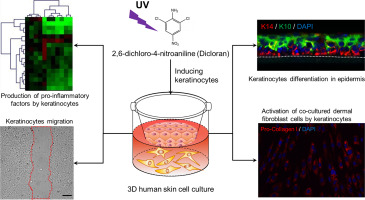Environment International ( IF 11.8 ) Pub Date : 2018-10-18 , DOI: 10.1016/j.envint.2018.10.010 Wei Xu , Emily N. Vebrosky , Kevin L. Armbrust

|
Exposure to sunlight and certain pesticides can induce phototoxic responses. Long- and short-term exposure to the photoactivated pesticides can cause a variety of skin diseases. However, assessment of pesticide phototoxicity on human skin is difficult. In the present study, human skin keratinocytes were cultured in several forms: monolayer cell sheet, three-dimensional culture, and keratinocyte-fibroblast co-culture. A common fungicide, dicloran (DC, 2,6‑dichloro‑4‑nitroaniline), was irradiated with simulated sunlight for 2 (DC-PD-2h) and 4 (DC-PD-4h) hours. Dicloran, and two purified intermediate photodegradation products, 2‑chloro‑1,4‑benzoquinone (CBQ) and 1,4‑benzoquinone (BQ), were applied in toxicity tests independently with the keratinocyte culture models. The cell migration, cell differentiation, pro-inflammatory molecule production, and dermal fibroblast cell activation were all measured in the keratinocytes treated with the chemicals described above. These parameters were used as references for dicloran phototoxicity assessment. Among all tested chemicals, the DC-PD-4h and BQ demonstrated elevated toxicities to the keratinocytes compared to dicloran based on our results. The application of DC-PD-4h or BQ significantly delayed the migration of keratinocytes in monolayer cell sheets, inhibited the keratinocyte differentiation, increased the production of pro-inflammatory molecules by 3D keratinocyte culture, and enhanced the ability of 3D cultured keratinocytes in the activation of co-cultured dermal fibroblast cells. In contrast, dicloran, DC-PD-2h, and CBQ showed minimal effects on the keratinocytes in all assays. The results suggested that the four-hour photodegraded dicloran was likely to induce inflammatory skin diseases in the natural human skin. The 1,4‑benzoquinone, which is the predominant degradation product detected following 4 h of irradiation, was the main factor for this response. Photoactivation increased the risk of skin exposed to dicloran in nature. Our models provided an efficient tool in the assessment of toxicity changes in pesticide following normal use practices under typical environmental conditions.
中文翻译:

暴露于水中的双氯然光降解产物对人体皮肤细胞的潜在风险
暴露在阳光和某些农药下会引起光毒性反应。长期和短期接触光活化农药会导致多种皮肤疾病。但是,很难评估农药对人皮肤的光毒性。在本研究中,以多种形式培养人皮肤角质形成细胞:单层细胞片,三维培养和角质形成细胞-成纤维细胞共培养。普通杀菌剂双氯兰(DC,2,6-二氯-4-硝基苯胺)用模拟阳光照射2(DC-PD-2h)和4(DC-PD-4h)小时。双氯兰和两种纯化的中间光降解产物2-氯-1,4-苯醌(CBQ)和1,4-苯醌(BQ)分别与角质形成细胞培养模型一起用于毒性测试。细胞迁移,细胞分化,促炎分子的产生,在用上述化学试剂处理过的角质形成细胞中,均测定了皮肤的成纤维细胞和真皮成纤维细胞的活化。这些参数用作双氯兰光毒性评估的参考。在所有测试的化学药品中,根据我们的结果,与双氯仑相比,DC-PD-4h和BQ对角质形成细胞的毒性增强。DC-PD-4h或BQ的应用显着延迟了单层细胞片中角质形成细胞的迁移,抑制了角质形成细胞的分化,通过3D角质形成细胞培养增加了促炎分子的产生,并增强了3D培养的角质形成细胞的激活能力共培养的真皮成纤维细胞。相比之下,双氯兰,DC-PD-2h和CBQ在所有测定中对角质形成细胞的影响均微乎其微。结果表明,经过四小时的光降解的双氯仑可能会在自然人的皮肤上诱发炎症性皮肤病。1,4-苯醌是辐照4小时后检测到的主要降解产物,是造成此反应的主要因素。光活化增加了自然界中双氯兰暴露于皮肤的风险。我们的模型为评估农药在典型环境条件下的正常使用情况下的毒性变化提供了有效的工具。



























 京公网安备 11010802027423号
京公网安备 11010802027423号